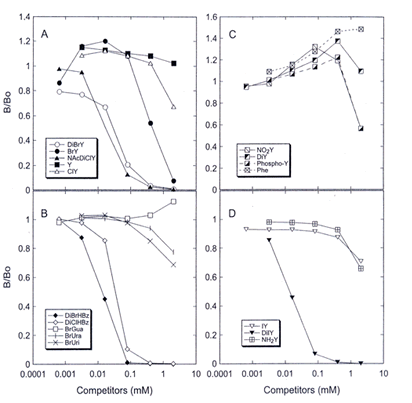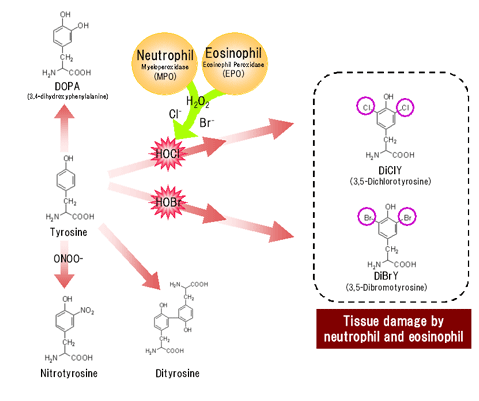50
Anti Dibromo-Tyrosine (DiBrY) monoclonal antibody
- SKU:
- 50-MBY-020P-GEN
- Availability:
- Usually ships in 5 working days
Description
Anti Dibromo-Tyrosine (DiBrY) monoclonal antibody
A novel biomarker for protein oxidation

Neutrophils and eosinophils play an important role in the defence system against microbial infection. Myeloperoxidase (MPO) and eosinophil peroxidase (EPO) are known to catalyze formation of hypochlorous acid (HOCl) and hypobromous acid (HOBr). These reactive intermediates may react with proteins, lipids and nucleotides, and it has been reported to form tyrosine halogenation such as dibromotyrosine (DiBrY). DiBrY is a Br-modified tyrosine at 3- and 5- position, which is one of the major oxidative products derived from neutrophil myeloperoxidase.
Specific to dihalogenated tyrosine at 3- and 5-position

Monoclonal antibody clone 3A5 have been established by Dr. Toshihiko Osawa (Nagoya Univ.) and Dr. Yoji Kato (Univ. Hyogo). This antibody is specific for 3,5-Dibrominated tyrosine and other di-halogenated tyrosine at 3- and 5- position. Suitable for immunohistochemical analysys of oxidative stress.
Oxidative modification of tyrosine

Tyrosine is one of the main targets of protein oxidation, and it have been reported form nitrotyrosine, dityrosine and halogenated tyrosines depending on the type of free radicals. For example, hypochlorous acid (HOCl) and hypobromous acid (HOBr) are derived from neutrophil myeloperoxidase (MPO) and eosinophil peroxidase (EPO), and known to form dihalogenated tyrosines such as DiBrY, DiClY and DiIY. It is expected that DiBrY may be a novel biomarker for tissue damage which is related to inflammatory and allergic disorders.
| Halogenated tyrosine related diseases | ||||||||
|
| Specifications | ||||||||||||
|
Additional Information
Size: |
20 ug of IgG/vial |
Type of Marker: |
Protein oxidation |
Marker: |
NO-modification |
Storage: |
Less than -20°C |
Usage: |
Tissue |
Application: |
Immunohistochemistry, western blotting and ELISA |
Remark: |
A novel nitrosative stress marker. Protein tryptophan residues are known to be the target of peroxynitrite to form tryptophan derivatives. |



![Anti-Dibromo-Tyrosine Antibody [3A5] | MC-1102 Anti-Dibromo-Tyrosine Antibody [3A5] | MC-1102](https://cdn11.bigcommerce.com/s-1rdwiq712m/images/stencil/590x590/products/440872/445701/gentaur-genprice__26005.1661610467__29809.1661628092__75433.1661676199__77988.1661684280__64362.1661692443__02085.1662049603__45075.1662119302__91744.1662191540__21580.1662291419__31402.1663312634.png?c=1)


